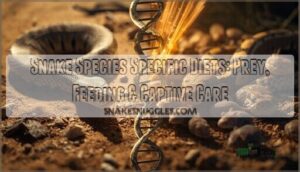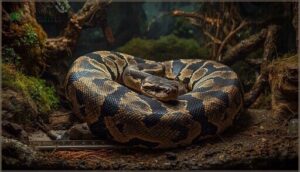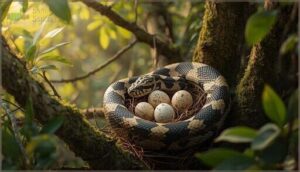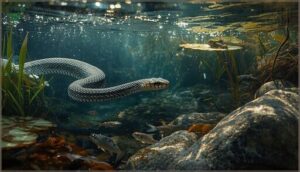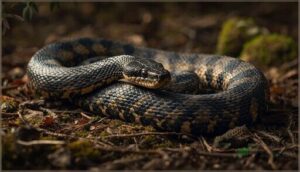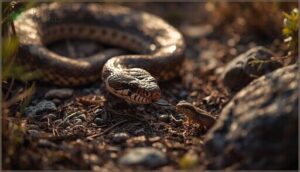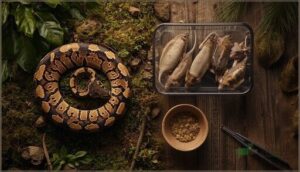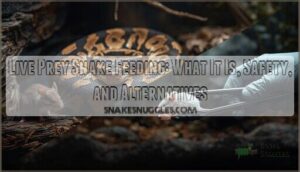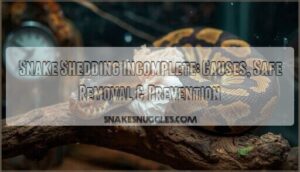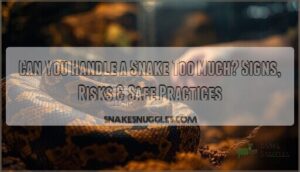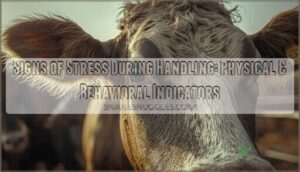This site is supported by our readers. We may earn a commission, at no cost to you, if you purchase through links.
A California kingsnake that readily devours rattlesnakes won’t touch a mouse, while a ball python bred for generations on rodents might starve rather than accept a bird. Your snake’s dietary blueprint isn’t just written in its species name—it’s encoded in millions of years of evolutionary specialization that shaped everything from jaw mechanics to digestive enzymes.
Understanding snake species-specific diets means recognizing that a reticulated python and a rough green snake inhabit entirely different nutritional universes, despite sharing the same basic body plan.
Getting this match right determines whether your captive snake thrives or merely survives, because forcing the wrong prey on a specialized feeder creates chronic stress, nutritional gaps, and feeding refusal that no supplement can fix.
Table Of Contents
Key Takeaways
- Specialized snake diets aren’t preferences but evolutionary adaptations—feeding your snake the wrong prey type creates chronic stress, nutritional gaps, and feeding refusal that no supplement can fix.
- Frozen-thawed whole prey is superior to live feeding because it eliminates injury risks to your snake, provides complete nutrition (calcium, phosphorus, vitamins, and bone matter that muscle tissue alone can’t replicate), and aligns with responsible captive care.
- Proper environmental conditions—temperature around 30–32°C, species-appropriate humidity, adequate UVB lighting for vitamin D3 synthesis, and stress reduction—directly determine whether your snake digests efficiently or refuses food altogether.
- Prey sizing matters critically: aim for 1.0–1.5 times your snake’s thickest body diameter and 10–15% of body weight per meal, while adjusting protein (25–30% for juveniles, 15–20% for adults) and feeding frequency (every 5–7 days for hatchlings, every 10–21 days for adults) based on age and species.
Snake Species and Their Natural Diets
Snakes have evolved remarkably specialized diets, with each species targeting specific prey types that match their hunting methods and habitats.
Understanding what your snake naturally eats in the wild isn’t just interesting—it’s essential for providing proper nutrition in captivity.
Let’s look at the major dietary categories and the species that fall into each group.
Mammal-Eating Snakes (e.g., Pythons, Kingsnakes)
Mammal-eating snakes like pythons and kingsnakes showcase impressive gape capabilities, with reticulated pythons swallowing prey equal to their body weight. In California kingsnakes, mammals constitute 29% of diet items—130 of 447 recorded prey—while larger individuals preferentially target rodents.
Wild pythons consume mammals comprising 70-75% of their diet, though captive feeding with appropriately sized frozen-thawed rodents ensures safer nutrition. Burmese pythons, for example, have a surprisingly large maximum snake gape.
Bird and Egg Specialists
While most snakes target mammals, specialized egg-eaters like Dasypeltis occupy a unique dietary niche, consuming only bird eggs. These arboreal specialists use egg-cracking adaptations—vertebral hypapophyses that crush shells internally after swallowing whole eggs. They are classified within the Colubridae family.
These snakes practice seasonal fasting between nesting periods, while generalist species incorporate nestling predation alongside eggs. Prey selection is based on arboreal access and availability within their snake species diet.
Fish and Amphibian Feeders
Aquatic snake species like Northern Watersnakes consume fish equaling 5–10% of their body mass per meal, with cyprinids dominating aquatic snake diets. Lake Erie populations forage within 150 meters of shore, consuming up to 3.3 million Round Gobies annually.
Grass snakes demonstrate amphibian nutrient transfer by deriving 83.9% of prey from frogs and tadpoles.
Understanding fish prey specialization and watersnake foraging ecology helps you replicate natural prey preferences during captive amphibian feeding.
Insectivorous and Worm-Eating Snakes
Smaller-bodied species like threadsnakes specialize in ant brood diets, with larvae and pupae comprising over 80% of stomach contents in fossorial microhabitats. Worm-eating snakes demonstrate elaborate worm handling behavior, aligning prey before swallowing when relative size exceeds 15%.
Calcium supplementation becomes critical for insectivorous snakes—unsupplemented insects provide far less calcium than vertebrate prey, risking metabolic disorders.
Habitat disturbance altering soil structure directly threatens these dietary specialists’ prey selection and feeding habits.
Reptile and Snake-Eating Species
Ophiophagy—snake-eating—appears in species like California kingsnakes, where snakes represent 29% of diet items yet contribute 45% of prey biomass. Cannibalism risks emerge in cape cobras consuming conspecifics at 4% frequency.
This dietary overlap drives venom resistance evolution and intense prey selection pressure. Kingsnakes demonstrate striking feeding habits, bending prey snake vertebral columns up to 50% shorter to overcome prey defenses during ingestion.
Prey Selection and Feeding Techniques
Snakes have evolved remarkably diverse hunting strategies, each suited to their prey, habitat, and physical capabilities. Some species rely on raw muscular power to subdue their meals, while others deploy chemical weapons with surgical precision.
Understanding these feeding techniques—and how diet has shaped snake evolution over millions of years—gives you critical insight into meeting your snake’s nutritional needs in captivity.
Constriction Versus Venom Delivery
When you’re feeding your snake, understanding constriction versus venom delivery mechanics reveals fascinating evolutionary advantages. Constrictors exert 8-14 PSI—anacondas reach over 90 PSI—modulating pressure to prey heartbeat for efficient kills.
Venomous snake behavior relies on venom composition specifically designed through gene duplication for specific prey toxicity.
Remarkably, 38% of species swallow prey alive, while dietary specialization determines whether constrictor diets favor strength or venomous snake diets prioritize speed and agility.
Ambush Predators Vs. Active Hunters
When you observe snake species diet differences, ambush predators versus active hunters reveal distinct feeding patterns shaped by evolutionary origins. Ambush predators like timber rattlesnakes maintain lower metabolic rates (14-23% reduced hematocrit), targeting larger prey size with fewer strikes annually—just 12-15 attacks consuming 1245-1552g biomass. Active hunters achieve greater hunting efficiency through frequent movement, though requiring fivefold higher energy intake, demonstrating how prey selection strategies directly impact strike success and survival.
- Timber rattlesnakes spend extended periods motionless, documenting 722 ambush instances over 17 years
- Active foragers process meals 2.257 days faster than ambush specialists due to elevated metabolic rates
- Southwestern speckled rattlesnakes show 80.8% mammalian preference as ambush specialists
- Active hunters abandon non-rewarding sites quickly, enhancing patch efficiency over patient ambush tactics
Whole Prey Importance for Nutrition
You can’t replicate whole prey nutrition with muscle tissue alone—intact carcasses deliver the calcium and phosphorus balance your snake’s bone health demands, usually 1:1 to 2:1 ratios from skeletal elements. Organ tissues supply fat-soluble vitamins A and E, while digestion physiology evolved to extract essential nutrients from fur, feathers, and bones.
Whole prey delivers the calcium, phosphorus, vitamins, and bone matter your snake’s digestion evolved to extract—muscle tissue alone can’t replicate that
Prey diversity matters: rotating rodent nutrition sources with avian or reptilian options prevents micronutrient gaps that single-species feeding creates.
Evolutionary Adaptations in Diet
Cranial kinesis turned snake skulls into expandable feeding machines—your ball python’s quadrate bone elongation lets it swallow prey 150% wider than its head. Evolution didn’t stop there:
- Venom toxicity in arthropod-feeding Echis vipers evolved prey-specific formulas
- Body form in sea snakes stretched narrow for probing burrows
- Gut physiology shifted microbiota to match dietary variations among snake species
- Arms races with toxic newts drove garter snake resistance through localized selection
These specialized diets showcase millions of years refining prey selection strategies.
Dietary Needs in Captivity
Keeping snakes in captivity means you’re taking on the full responsibility of meeting their nutritional needs, which doesn’t always mirror what happens in the wild. The choices you make about prey type, size, and feeding schedule can directly impact your snake’s health, growth, and longevity.
Let’s walk through the key considerations that will help you feed your captive snake properly.
Frozen-Thawed Vs. Live Prey
Ever wondered why frozenthawed prey has become the preferred method in snake feeding safety? The benefits of frozenthawed prey—consistent Prey Nutritional Value, reduced Risks of feeding live prey, and lower Cost Analysis—far outweigh live feeding.
Ethical Considerations and practical husbandry favor it, too. Unless your snake’s preference absolutely demands it, live feeding invites avoidable injuries and stress.
Prey Size and Age Appropriateness
Selecting the right prey isn’t just about what your snake will swallow—it’s about what it can digest safely. Girth-based guidelines recommend prey 1.0–1.5 times your snake’s thickest body diameter, while weight percentage targets around 10–15% of body mass per meal. Proper prey sizing respects biomechanical limits and drives positive health outcomes.
Consider these benchmarks for prey age and girth matching:
- Extra-small pinkies (1.5–1.99 g) suit neonatal snakes 7–14 days old
- Small pinkies (2.00–2.49 g) support rapid early growth phases
- Peach fuzzies (3.00–4.49 g) bridge the gap to juvenile snake diets
- Hoppers (7.00–12.99 g) match subadult mid-body circumference
- Weanlings (13.00–17.99 g) fit snakes approaching adult prey selection
Exceeding 1.5-times girth or 15% body weight invites regurgitation, esophageal trauma, and prolonged digestion—risks you can sidestep with thoughtful prey sizing.
Balancing Diet for Juveniles Vs. Adults
Your juvenile snake’s protein requirements run 25–30% to fuel explosive growth, while adults thrive on 15–20% for maintenance. Calcium needs shift too—juveniles demand 1.5–2.0% to build skeleton, adults need just 0.8–1.2%. Fat intake follows the same pattern: juveniles burn 8–12%, adults 5–8%.
This nutritional pivot reflects metabolic slowdown and fosters healthy gut microbiota as your snake matures.
Feeding Frequency and Schedules
Once you’ve dialed in nutrition, feeding frequency and schedules become your next checkpoint. Age-based schedules matter—hatchlings thrive on meals every 5–7 days, adults every 10–14. Species-specific needs vary too: ball pythons stretch to 21 days, while corn snakes prefer weekly. Factor in seasonal adjustments for brumation timing, and always adjust based on body condition rather than rigid intervals.
- Hatchlings: Feed every 5–7 days to support rapid growth
- Juveniles: Offer prey every 7–10 days as metabolism stabilizes
- Adults: Schedule meals every 10–21 days depending on species
- Pre-brumation: Stop feeding early November, allowing digestive clearing
- Overweight snakes: Extend intervals to 21–35 days for gradual weight loss
Environmental Factors Affecting Snake Diets
You can’t just toss a snake in an enclosure and expect it to thrive—environmental conditions directly influence how well your snake digests its meals, stays hydrated, and maintains appetite. Temperature, humidity, lighting, and stress levels all play critical roles in whether your snake feeds consistently or refuses food altogether.
Let’s break down each factor so you can fine-tune your setup for best feeding and health.
Temperature and Digestion Efficiency
Your snake’s digestion hinges on temperature—it’s not just about comfort, it’s about metabolic efficiency. At optimal temperatures around 30–32°C, the digestion rate accelerates dramatically, completing gastric processing in roughly 60 hours compared to days at cooler levels.
This thermophilic behavior ensures energy assimilation stays high while digestive systems work efficiently. Poor temperature management leads to regurgitation and spoiled prey, directly impacting health outcomes and feeding success.
Humidity and Hydration Needs
Beyond temperature, humidity impact on hydration shapes your snake’s digestive health and shedding success. Preferred ranges sit between 35–70%—below that, you’ll see shedding difficulties and dehydration risks; above it, humidity diseases like blister infections emerge.
Watch drinking behavior closely, as snakes rely on both prey moisture and fresh water to meet dietary needs.
Species-specific environmental factors matter: tropical pythons need 60%, while desert colubrids thrive at 30–40%.
Lighting and Vitamin D3 Synthesis
While corn snakes absorb UVB (290–315 nm) through their skin to produce vitamin D3—essential for calcium absorption and bone health—you’ll also provide Dietary D3 Sources through whole prey. Without adequate D3, Deficiency Consequences include metabolic bone disease and weakened immunity.
Lighting Parameters recommend a UVI of 2.0–3.0 at basking zones, supporting Calcium and phosphorus balance.
Behavior Interactions show that proper UVB influences Snake dietary habits by maintaining the vigor needed for feeding.
Stress Impact on Appetite and Feeding
When acute stress hits—from handling, enclosure changes, or temperature swings—you’ll often see feeding refusal kick in within hours, driven by stress hormones that suppress appetite. Chronic anorexia follows if husbandry stressors persist, locking snakes into prolonged metabolic fasting.
This antipredator tradeoff is instinctual: your captive snake diet and feeding habits depend on eliminating environmental triggers to restore snake feeding safety.
Safe and Unsafe Foods for Snakes
Feeding your snake the right foods can mean the difference between a thriving reptile and one struggling with serious health issues. While snakes have straightforward dietary needs in theory, captive care brings unique challenges that can put your animal at risk if you’re not careful.
Let’s walk through what you should avoid, the real dangers of certain feeding practices, and how to spot trouble before it becomes critical.
Foods to Avoid in Captivity
Feeding your snake the wrong diet can derail its health faster than you’d expect. Certain items pose serious risks, from nutrient imbalances to outright toxicity. Here are inappropriate foods to avoid for snakes:
- Wild Prey Risks: Wild-caught rodents and amphibians carry parasites, pesticides, and pathogens—commercial feeders are safer.
- Thiaminase Concerns: Some fish deplete thiamine stores rapidly.
- Plant-Based Foods: Snakes can’t digest vegetation.
- Processed Human Foods: Seasonings and additives cause harm.
- Improper Thawing: Bacteria proliferate in poorly handled prey.
Risks of Feeding Live Prey
Live feeding poses severe prey injury risks—rodents defending themselves have inflicted bites leading to blindness, infection transmission, and even euthanasia in documented cases. Beyond physical trauma, animal welfare and ethical concerns have prompted legal constraints in jurisdictions like Australia, which prohibit prolonged live-vertebrate feeding.
Frozen-thawed safety eliminates these risks entirely while meeting your snake’s nutritional needs, making it the standard for responsible captive care.
Signs of Nutritional Deficiencies
When your snake’s diet falls short, subtle warning signs emerge before serious illness sets in. Watch for these deficiency symptoms that signal nutritional trouble:
- Metabolic Bone Disease – soft jawbones, limb deformities, and pathologic fractures from calcium or vitamin D3 shortfalls
- Thiamine Deficiency – neurologic abnormalities like head-tilting and convulsions in fish-eating species
- Poor Body Condition – prominent spines or sunken eyes indicating chronic undernutrition
- Shedding Problems – incomplete sheds often linked to micronutrient imbalances
Monitoring Health Through Diet
Systematic diet records transform your management of snake health. Track prey type, size, and frequency alongside weight checks and body condition scoring every 2–4 weeks.
This pairing reveals whether micronutrient balance promotes vitamin D3 synthesis or whether organ pathology risk climbs from overfeeding.
Serial monitoring catches nutritional needs shifting with growth—turning feeding history into your most powerful diagnostic tool.
Frequently Asked Questions (FAQs)
Can snakes survive on a vegetarian diet?
Unlike tortoises that munch lettuce, every snake is a committed carnivore—all 3,700-plus species rely entirely on animal prey.
Plant digestion limits make vegetarian diet attempts lethal, triggering starvation despite their evolutionary requirements for whole-animal nutritional completeness.
Do snakes drink water separately from prey?
Yes, snakes do drink water separately from prey. Dehydration triggers drinking behavior regardless of feeding, with species showing distinct hydration strategies—semi-aquatic Nerodia can compensate 125% of water deficits through voluntary drinking alone.
How do snakes locate prey in darkness?
In darkness, you’ll find snakes rely on infrared detection through pit organs, vomeronasal cues from tongue-flicking, and vibrational sensing via jaw bones—neural integration combines these signals for precision strikes.
Why do some snakes refuse to eat?
Feeding refusal in captive snakes often stems from husbandry issues, such as incorrect temperatures, stress from poor enclosures, and medical conditions like infections or parasites. Additionally, prey parameters, including size mismatches or unfamiliar types, can contribute to this behavior.
Environmental stressors, behavioral factors, and even seasonal brumation are known to trigger anorexia in these reptiles.
Can different snake species share the same diet?
Absolutely. Many captive snake species—corn snakes, kingsnakes, ball pythons, and colubrids—thrive on identical rodent-based diets.
However, gut microbiota studies show species with similar vertebrate diets develop comparable digestive profiles, suggesting dietary overlap works best when prey diversity matches each species’ natural feeding ecology.
Conclusion
Your snake’s next meal isn’t just food—it’s the cornerstone of everything working correctly inside its body. When you honor snake species specific diets, you’re not following arbitrary rules; you’re working with millions of years of precision engineering.
The kingsnake that refuses mice, the python that demands rodents—these aren’t quirks or preferences. They’re evolutionary truths that demand your respect. Match the prey to the predator, and watch your snake transform from merely surviving into genuinely thriving.
- https://pmc.ncbi.nlm.nih.gov/articles/PMC8516226/
- https://scholarworks.utep.edu/cgi/viewcontent.cgi?article=2508&context=open_etd
- https://besjournals.onlinelibrary.wiley.com/doi/10.1111/1365-2435.13446
- https://www.herpconbio.org/Volume_14/Issue_1/Wiseman_etal_2019.pdf
- http://eznc.org/CMS/The_Origins_of_Egg_Eating_in_Snakes/show.do?ctx=7795%2C169951%2C145075

